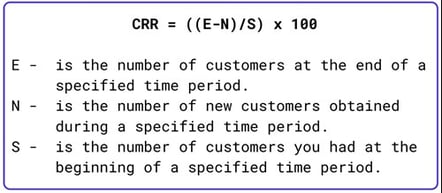Retention Rate
26 March 2020- 17 min read
26 March 2020- 17 min read
The SaaS landscape has grown exponentially over the last few years. As businesses continue to realize the vast potential of cloud-based services, the SaaS market is projected to grow to approximately $60 billion in value by 2023.
Customer Retention Rate Formula
CRR = ((E-N)/S) x 100
E – is the number of customers at the end of a specified time period.
N – is the number of new customers obtained during a specified time period.
S – is the number of customers you had at the beginning of a specified time period.
Businesses operating a SaaS platform and model are heavily reliant on customer retention for long-term success. A lost customer means lost revenue. Customer retention, its calculation, and helping customer retention rates grow are some of the crucial considerations for any business in the SaaS industry.
Customer retention is more than just a strategy to keep customers engaged and happy. This technique can also harness the power of selling while promoting loyalty, which keeps customers coming back or even better, signed up as a subscriber making recurring payments to your company.
Let’s learn more about it.
For most businesses, growing means gaining more customers. With SaaS platforms, customer retention is just as important as acquiring new customers. The key to growth is finding that sweet spot between managing and retaining your existing customers while acquiring new ones.
Customer retention is the foundation of profitable subscription-based services.
Your customer retention rate, or CRR, is the percentage of previous customers that you managed to retain in a period and is vital for SaaS businesses. Retaining previous customers is a lot less expensive than finding and on-boarding new ones.
Research shows that there’s a 5% to 20% chance of selling to a new prospect, which increases to a 60% to 70% chance when you are working with and looking to upsell to existing customers.
To retain customers, we must understand them first. That’s where the ‘customer life cycle’ comes in.
Managing your customer life cycle involves knowing your customers by analyzing their behavior and buying patterns. If you sell your SaaS platform on a subscription basis, you can manage this on an on-going basis in “real time”. However, even if you sell to customers on a one-off or sporadic basis, you can use their data effectively as a tool for analysis and business growth.
The customer life cycle is the steps a customer goes through before, during, and after they make or complete a transaction.
The different phases of customer lifecycle include:
A poll taken by Yotpo gives us a clearer insight into the importance of customer retention:
These are staggering numbers.
Now that we can see the importance of customer retention, we need to know how to measure it for accurate results.
Calculating customer retention rate is simple. Use the formula below:

You can understand the formula by removing customers from the end of a sales period from the new ones you gained during a sales period and divide that number with the number of customers you had at the beginning of the sales scheme.
Let’s look at a working example for a business working out their annual CRR.
Your customer has 1,450 customers at the end of the year. During the year you gained 600 new customers. At the start of the year you had 1,200 customers.
The calculation would therefore look like the below:
1,450 – 600 = 850
850/1,200 = 0.71
0.71 x 100 = 71% CRR for your business.
Want to dive more in-depth?
Download this free e-book for understanding how to calculate retention rate, what is retention rate, and understanding the customer retention rate formula, and the advantages of customer retention.
You can also use our calculator at the top of the page to work out your CRR for yourself.
When customer retention rates are higher, your business is more likely to be growing.
For SaaS companies, customer retention ensures a consistent stream of subscription-based revenue if you follow a subscription model.
Three of the most prominent benefits of higher retention rates are as follows:
With studies showing that acquiring a new customer can be as much as five times more expensive than retaining an existing one – retention is a significantly cheaper way to scale revenues.
Logically speaking, it is more efficient to keep existing customers then plan, spend, prepare, and invest additional time for newer ones.
Loyal customers keep coming back to your business.
According to a study, 90 percent of loyal customers spend more when buying from companies they are loyal to. Instead of investing more assets into finding newer customers, keeping old customers engaged and satisfied equates scalability.
Higher retention rates also encourage more profits.
A loyal customer is more likely to refer your service to their family, friends, and other people.
People trust recommendations coming from people they know, and that allows you to further your word-of-mouth campaign. In fact, customers acquired through referrals have a 37% higher retention rate.
Imagine your happy customer tells 10 people about your service. Each of those 10 people tells another 10 people about how great your service is, and so on.
Now imagine every single one of your customers does that. How much revenue would you make if even 2 in 10 of those people signed up?
You gain not only more traction, but recognition as a niche product that everyone yearns to be associated with.
This also shows us how customer retention can then circle round into new customer acquisition.
Companies who focus on their customer retention rates will always have the potential to scale, as they are likelier to benefit from word of mouth marketing.
The most important takeaways from this are to promote loyalty by delivering consistent service.
A brand can invest in the following to increase retention rates:
Retaining customers requires individual attention, and there are several ways of making sure they are well looked after.
Deals, special offers, gift ideas, and discounts are all ways of making sure your customers are in it for the long haul.
Customer retention rates must be high to give your business the conditions to scale. As well as being a great foundation for growth, a healthy retention rate can also act as a buffer and insurance policy for anything new you want to try. If a left field marketing campaign doesn’t work, for example, this might not be a huge issue as you know you have a loyal customer base already in place.
While acquiring new consumers remains a key business goal, ensuring that your current consumers stay with you is key to growing your business in the competitive SaaS environment.
Successful SaaS companies are built on the back of a high customer retention rate that allows for increased subscriptions. As an industry leader in automating subscription management, Upodi has carved a reputation for allowing SaaS companies to scale.
Have any questions? Contact us now.
Find out more about the author and follow them and social media to stay connected with them

Fanny Fredskilde is the Head of Project Management at Bonzer, providing external material to Upodi, that are suited for the SaaS business universe. She is eager to provide companies with the best content and track the development of companies based on her great experience within SEO.
Check out our related posts based on your search that you may like